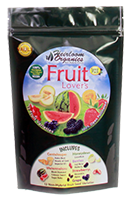|
Home > Guides > Fruits > Huckleberry |
|
How to Grow Huckleberry | Guide to Growing Huckleberries |
|
|
|
|
| |
 |
|
Overview |
|
|
|
|
|
| |
|
| |
These delicate translucent berries have been a source of food for generations of Northwest natives, animals and people alike. They are rich in vitamin C, available sugars and minerals like manganese. Not everyone enjoys their tangy-tart flavor. It is for this reason that the red huckleberries are usually combined with other berries, like the blueberry to add sweetness. |
|
| |
|
|
| |
Growing Guide
GROWING NOTES
Huckleberry can grow to more than 4' tall, and will produce many small white flowers which develop into dark purple berries late in the season.
Huckleberry is native to tropical regions, but can be grown successfully in cooler climates if started indoor in early spring and transplanted outdoors after the final frost of the spring once soil temperatures have reached 65 degrees or higher.
For best results, Huckleberry should be started indoors 4-6 weeks prior to the last frost of the season. Seeds should be sown at a shallow depth of ¼" and kept well-moistened until germination. Moderate water slightly once seeds begin to break through surface of the soil.
As seedling grows, transplant into a larger container one or more times as needed. Continue to grow in containers into early summer before transplanting.
MAINTAINING
Garden Huckleberry requires lots of direct sunlight, and will grow best in well-drained soil that is of moderate fertility.
|
|
| |
|
| |
Heirloom seeds are the gardeners choice for seed-saving from year-to-year. Learning to save seeds is easy and fun with these books. Before you harvest, consider which varieties you might want to save seeds from so that your harvesting practice includes plants chosen for seed saving. Be sure to check out our newest seed packs, available now from Heirloom Organics. The Super Food Garden is the most nutrient dense garden you can build and everything you need is right here in one pack. The Genesis Garden s a very popular Bible Garden collection. The Three Sisters Garden was the first example of companion planting in Native American culture. See all of our brand-new seed pack offerings in our store.
|
|
| |
|
|
| |
Harvesting Guide
HARVESTING
The ripe berries can be collected after they have turned black and begin to soften. Allowing the berries to stay on the plant longer will produce better, richer flavor.
SAVING SEEDS
Seeds can be collected when the berries reach full maturity. Break open berries and place contents into a bowl. Continue to separate seeds from pulp, and seeds will sink to bottom.
Dry seeds and store in a sealed container in a cool location out of direct sunlight and with low humidity.
|
|
| |
|
|
|
| |
|
|
|
|
|
| You can find this variety in the following Seed Packs: |
|

 |
|
| Click the packs below to see some of our other wonderful products |
|
|
|
|
|
|
|